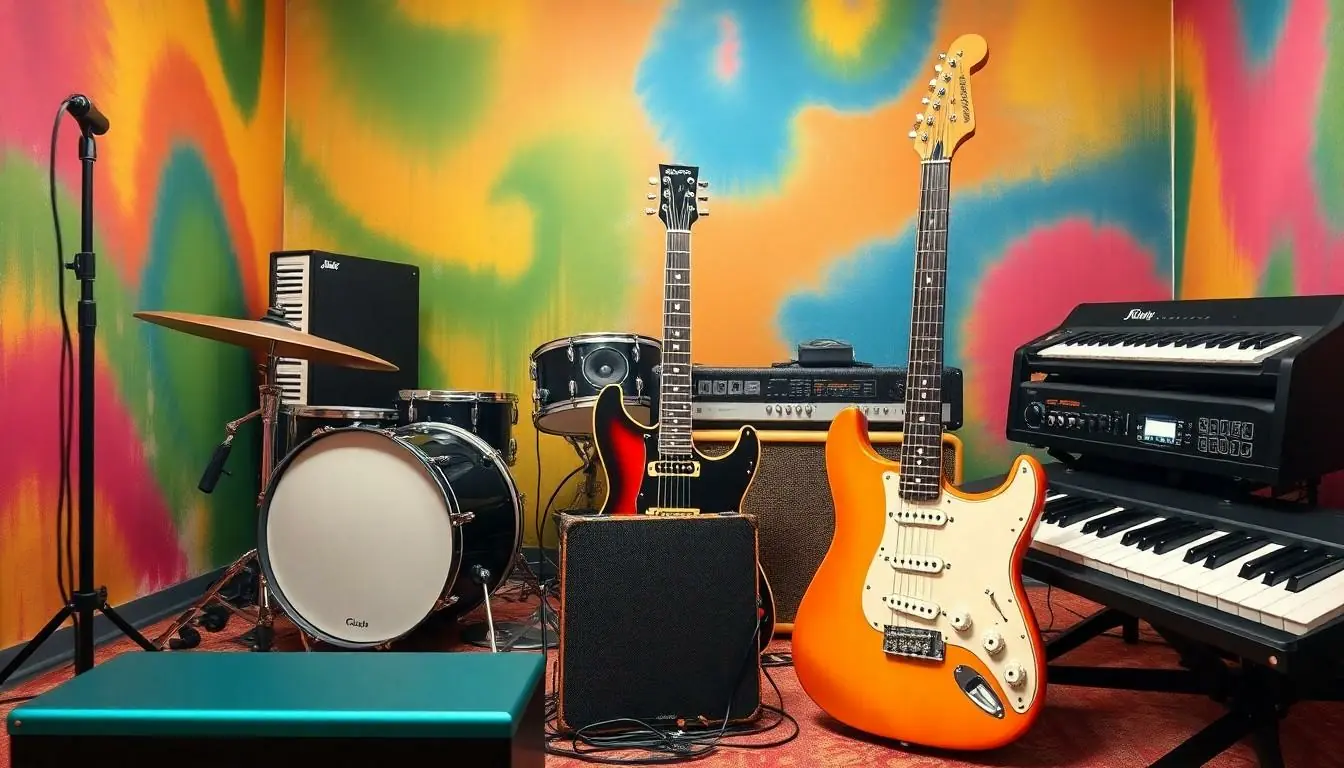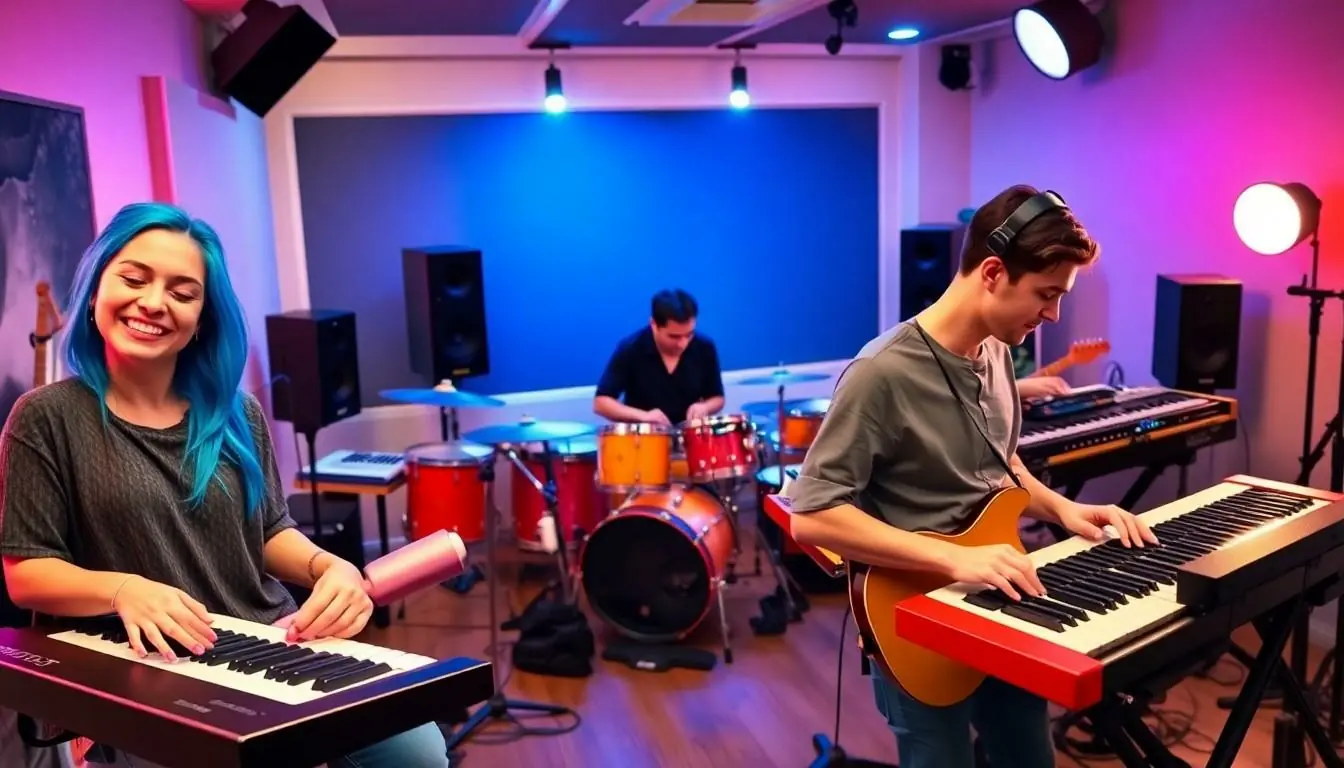Pop music isn’t just about catchy hooks and infectious beats; it’s also a vibrant tapestry woven from an array of instruments that bring those melodies to life. From synths that buzz like a caffeinated bee to guitars that scream louder than your neighbor’s lawnmower, the world of pop instruments is as diverse as the genres themselves.
Ever wondered what makes your favorite pop anthem stick in your head? It’s all in the instrumentation! These tools of sonic magic create the backdrop for the artists’ voices and lyrics, turning simple tunes into chart-topping hits. So, let’s dive into the colorful world of pop music instruments and discover how they shape the soundtracks of our lives—because who doesn’t want to be the cool kid at the next trivia night?
Table of Contents
ToggleOverview Of Pop Music Instruments
Various instruments play pivotal roles in crafting the sound of pop music. Synthesizers create electronic textures, rendering catchy melodies that resonate with listeners. Guitars, both electric and acoustic, add a rhythmic backbone, complementing vocal lines and enhancing energy. Drums provide the fundamental beat, driving the pace of songs and helping to establish a strong groove.
Keyboards expand the range of sounds, offering everything from bright leads to lush pads that fill out the sonic space. Bass guitars deliver depth, anchoring arrangements and influencing the overall feel. Strings, like violins and cellos, introduce warmth, often elevating emotional peaks in ballads.
Percussion instruments, such as tambourines and shakers, introduce subtle nuances and enrich the texture of a track. Wind instruments, including saxophones and trumpets, can add distinct flavors, often seen in crossover hits that embrace jazz and funk influences. Samples and loops, often sourced from earlier recordings, contribute unique elements, adding layers that appeal to modern audiences.
Each instrument serves a specific function within a band or production, contributing to the interwoven tapestry of sound. The combination of these various instruments creates the innovative and engaging soundscapes that define pop music. Understanding these instruments enhances appreciation, highlighting the artistry behind beloved tracks. Overall, the synergy among these instruments plays a crucial role in establishing the identity and appeal of popular music.
Common Instruments Used In Pop Music

Pop music relies on a variety of instruments to create its signature sound. Understanding these instruments helps appreciate the artistry in popular songs.
Rhythm Section Instruments
Drums serve as the heart of pop tracks. Their beats maintain the song’s tempo, establishing a lively atmosphere. Bass guitars complement drums, providing depth and groove that keeps listeners engaged. Percussion instruments, like tambourines and shakers, add texture and enhance rhythmic complexity, creating a fuller sound. Together, these instruments form the backbone of pop music, driving energy and inviting movement.
Melodic Instruments
Synthesizers bring captivating electronic sounds and catchy melodies to the forefront. Guitars, in both acoustic and electric forms, weave in harmonic layers and striking riffs, adding to the song’s texture. Keyboards enrich the arrangement with bright leads and lush pad sounds, creating a dynamic spectrum of notes. Strings like violins and cellos infuse emotional warmth and depth, particularly in slower tracks. Each melodic instrument contributes distinct characteristics, enhancing listener engagement and elevating the overall experience of pop music.
Evolution Of Pop Music Instruments
Pop music instruments have undergone significant changes over the decades, shaped by cultural shifts and technological innovations. This evolution highlights how instruments have influenced the sound of pop music.
Historical Milestones
The 1950s marked the arrival of electric guitars, which transformed rock and pop music dynamics. In the 1960s, bands like The Beatles incorporated strings and brass, broadening pop’s sonic palette. The 1970s saw synthesizers gain popularity, allowing for innovative electronic sounds. Significant genres emerged, such as disco, which relied heavily on rhythmic elements. The 1980s further advanced the use of technology with the advent of MIDI and sequencers, enabling intricate arrangements. By the 1990s and 2000s, pop music embraced sampling techniques, introducing diverse influences, and expanding instrumentation beyond traditional boundaries.
Technological Advances
Technological innovations significantly altered pop music instrumentation. The introduction of the synthesizer revolutionized sound generation, offering limitless possibilities. Digital audio workstations empowered producers to manipulate audio with precision. Instruments became more accessible with the rise of affordable equipment. Virtual instruments gained popularity, allowing musicians to create complex arrangements without physical setups. Additionally, the internet facilitated collaboration among artists worldwide, promoting fusion genres. These advancements fostered creativity while enabling the emergence of distinct pop sounds that resonate across global audiences.
Impact Of Technology On Pop Music Instruments
Technology has dramatically transformed the landscape of pop music instruments. Innovations in digital and software have shaped how artists create and produce music.
Digital Instruments
Digital instruments define modern pop music. Synthesizers offer a range of sounds, from lush pads to sharp leads. Electric guitars blend traditional rock tones with digital effects. Drum machines provide precise beats that enhance production quality. Furthermore, MIDI controllers allow musicians to manipulate sounds right from their keyboards. Many artists appreciate the versatility these digital instruments bring, enabling them to experiment with new styles and genres more easily.
Software and Production Tools
Production tools have revolutionized how pop music is crafted. Digital audio workstations, such as Ableton Live and Logic Pro, allow seamless audio recording and editing. These platforms offer vast libraries of virtual instruments and samples. With loop-based production, artists create intricate tracks quickly. Access to plugins enhances sound design, providing effects that range from reverb to distortion. Additionally, collaboration tools facilitate communication between artists, no matter the distance. The ease of use and accessibility of these tools empowers musicians to push creative boundaries.
The diverse array of instruments in pop music plays an indispensable role in shaping its sound and appeal. Each instrument contributes its unique characteristics to create the catchy melodies and rhythms that define popular songs. As technology continues to evolve, so does the instrumentation used in pop music, allowing artists to explore new creative avenues.
Understanding the synergy between rhythm and melodic instruments enhances listeners’ appreciation of their favorite tracks. It’s clear that the evolution of these instruments not only reflects cultural shifts but also pushes the boundaries of what pop music can achieve. As fans delve deeper into the world of pop instrumentation, they’ll discover a richer, more nuanced experience that goes beyond just lyrics and vocals.


